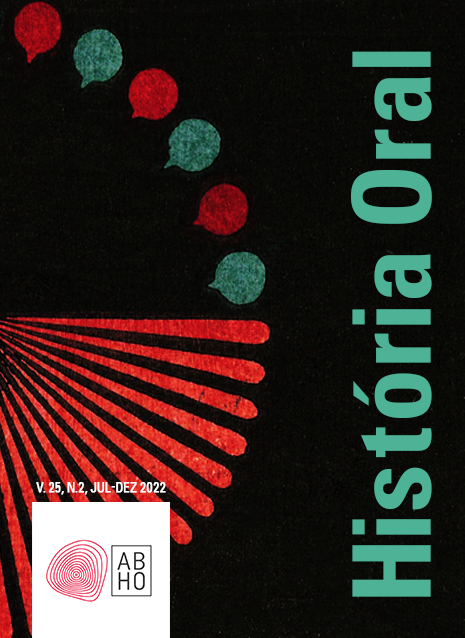Oral narratives and visual sources: a methodology to know phenomenological relationships between subjects and old places of work
DOI:
https://doi.org/10.51880/ho.v25i2.1267Keywords:
industrial heritage, phenomenological relations, narratives, history of PelotasAbstract
This article presents a methodology created with the objective of knowing the intangible dimension – formed by memories, meanings and perceptions – existing among subjects of different groups about the industrial heritage of the “Zona do Porto”, in the city of Pelotas (RS). From the identification of a problem related to the preservation and reuse of the local industrial heritage, the proposal was developed by a dialectical analysis, through the progressive-regressive movement (Lefebvre, 2013), added to the combination of data collection instruments such as mental maps, semi-structured interview based on in the methodology of Oral History and photo/object-elicitation, constituting an efficient set of oral narratives that complemented with visual sources. Following the recommendations of the Seville Charter (TICCIH-Brasil, 2018) which indicates the need to think about more inclusive participatory models for citizens, the research sought to know these intangible aspects, so that they can integrate with new forms of preservation and legitimation with civil society, and thus strengthen the sense of belonging of the community with its heritage. The methodology based on the alternation of narratives (oral and visual) performed appropriately to approach the issues of memory, resignifications of the old industrial spaces and thus promote the preservation and valorization of the industrial heritage of the city of Pelotas.
References
BAUER, Letícia; BORGES, Viviane Trindade (Org.). História oral e patrimônio cultural: potencialidades e transformações. São Paulo: Letra e Voz, 2018.
BENJAMIN, Walter. Magia e técnica, arte e política: ensaios sobre literatura e história da cultura. São Paulo: Editora Brasiliense, 1987. (Obras Escolhidas, 1).
CANDAU, Joel. Memória e identidade. São Paulo: Contexto, 2018.
CHOAY, Françoise. A alegoria do patrimônio. 3. ed. São Paulo: Estação Liberdade: Unesp, 2006.
CULLEN, Gordon. Paisagem urbana. Lisboa: Edições 70, 2013.
DUARTE, Cristovão Fernandes. A dialética entre permanência e ruptura nos processos de transformação do espaço. Mundo Urbano, 1 ago. 2010. Disponível em: https://cristovao1.wordpress.com/2010/08/01/a-dialetica-entre-permanencia-e-ruptura-nos-processos-detransformacao-do-espaco/. Acesso em: 30 jun. 2022.
GUTIERREZ, Ester Judite Bendjouya. Negros, charqueadas e olarias: um estudo sobre o espaço pelotense. 2. ed. Pelotas: Editora UFPel, 2001.
JOVCHELOVITCH, Sandra; BAUER, Martin. Entrevista narrativa. In: BAUER, Maritn; GASKELL, George (Ed.). Pesquisa qualitativa com texto, imagem e som: um manual prático. Petrópolis: Vozes, 2008. P. 90-113.
LEFEBVRE, Henri. La producción del espacio. Madrid: Capitán Swing Libros, S.L. 2013.
LYNCH, Kevin. A imagem da cidade. São Paulo: Martins Fontes, 1997.
MANGUEL, Alberto. Lendo imagens. São Paulo: Companhia da Letras, 2001.
MENDONÇA, José Ricardo Costa de; VIANA, Marcilio Freire Tabosa. Entrevista com Foto-Elicitação (EFE): o uso de métodos visuais para o estudo do ambiente físico nas organizações. In: ENCONTRO DE ENSINO E PESQUISA EM ADMINISTRAÇÃO, 1., 2007, Recife. Anais… Maringá: Anpad, 2007.
MENEGUELLO, Cristina. As ruínas do futuro e o novo patrimônio industrial: entrevista com Cristina Meneguello. Contexto, Mossoró, v. 4, p. 249-255, 2014.
NORBERG-SCHULZ, Christian. O fenômeno do lugar. In: NESBITT, Kate (Org.). Uma nova agenda para a arquitetura: antologia teórica (1965-1995). 2. ed. São Paulo: Cosac Naify, 2008. 443-461.
PANOFSKY, Erwin. Significado nas artes visuais. São Paulo: Perspectiva, 1991.
PELOTAS. Lei nº 4.568, de 7 de julho de 2000. Declara área da cidade como zonas de preservação do patrimônio cultural de Pelotas – ZPPC’s – lista seus bens integrantes e dá outras providências. Pelotas: Câmara Municipal, 2000.
PELOTAS. Lei nº 5.502, 11 de setembro de 2008. Institui o III Plano Diretor Municipal e estabelece as diretrizes e proposições de ordenamento e desenvolvimento territorial no Município de Pelotas, e dá outras providências. Pelotas: Câmara Municipal, 2008.
PORTELLI, Alessandro. Prefácio. In: MATOS, Ana Cardoso de; SALES, Telma Bessa (Coord.). Conversando sobre património industrial e outras histórias: palavras, espaços e imagens. Sobral: Edições UVA, 2018. 7-9.
PORTELLI, Alessandro. História oral como arte de escuta. São Paulo: Letra e Voz, 2016.
RICOEUR, Paul. Arquitetura e narratividade. Urbanisme, n. 303, p. 44-51, nov./dez. 1998.
VON SIMSON, Olga Rodrigues de Morais. Imagem e memória. In: SAMAIN, Etienne (Org.) O fotográfico. São Paulo: Hucitec: Senac São Paulo, 2005. p. 18-34.
SANTOS, Milton. A natureza do espaço: técnica e tempo, razão e emoção. São Paulo: Edusp, 2006.
SOSA GONZÁLEZ, Ana María. A UFPel, a cidade de Pelotas e seu patrimônio industrial: uma reflexão e sistematização a partir do projeto “Memória, identidade e patrimônio industrial adquirido pela UFPel”. In: MICHELON, Francisca Ferreira. [Org.] O patrimônio industrial da Universidade Federal de Pelotas. Pelotas: Editora UFPel, 2019. p. 85-123. Disponível em: http://guaiaca.ufpel.edu.br:8080/handle/prefix/4869. Acesso em: 30 jun. 2022.
TICCIH-Brasil - COMITÊ BRASILEIRO PARA A PRESERVAÇÃO DO PATRIMÔNIO INDUSTRIAL. Cartas Patrimoniais. Carta de Nizhny Tagil sobre o Patrimônio Industrial. 2003. Disponível em: https://ticcihbrasil.org.br/?page_id=675. Acesso em: 13 jul. 2022.
TICCIH-Brasil - COMITÊ BRASILEIRO PARA A PRESERVAÇÃO DO PATRIMÔNIO INDUSTRIAL. Cartas Patrimoniais. Princípios de Dublin. 2011. Disponível em: https: https://ticcihbrasil.org.br/?page_id=686. Acesso em: 13 jul. 2022.
TICCIH-Brasil - COMITÊ BRASILEIRO PARA A PRESERVAÇÃO DO PATRIMÔNIO INDUSTRIAL. Carta de Sevilha de Patrimônio Industrial. 2018. Disponível em: https://ticcihbrasil.org.br/?p=1042. Acesso em: 13 jul. 2022.
TUAN, Yi-Fu. Topofilia: um estudo da percepção, atitudes e valores do meio ambiente. São Caetano do Sul: Difusão Editorial, 1974.
TUAN, Yi-Fu. Espaço e lugar: a perspectiva da experiência. Londrina: Eduel, 2013.
VIEIRA, Sidney Gonçalves. A cidade fragmentada, o planejamento e a segregação social do espaço urbano em Pelotas. Pelotas: Editora UFPel, 2005.
Downloads
Published
How to Cite
Issue
Section
License
Copyright (c) 2022 História Oral

This work is licensed under a Creative Commons Attribution-NonCommercial-NoDerivatives 4.0 International License.
A revista História Oral é licenciada de acordo com a atribuição Creative Commons BY-NC-ND 4.0 (Atribuição-NãoComercial-SemDerivações 4.0 Internacional). Dessa forma, os usuários da revista têm o direito de compartilhar livremente o material, copiando-o e redistribuindo-o em qualquer suporte e formato, desde que sem fins comerciais, fornecendo o crédito apropriado e não realizando mudanças ou transformações no material. Para maiores informações, ver: https://creativecommons.org/licenses/by-nc-nd/4.0/deed.pt_BR








